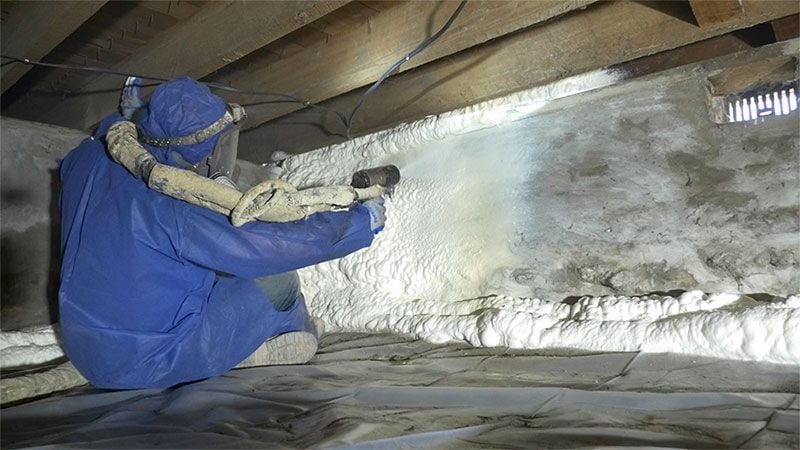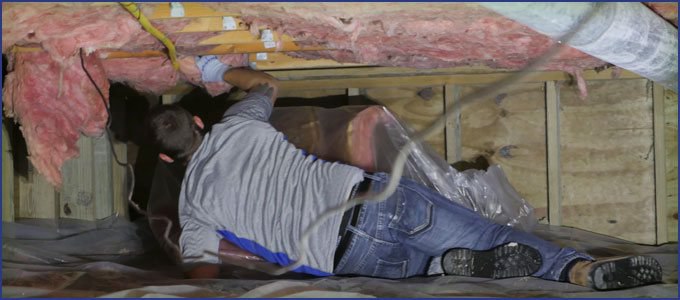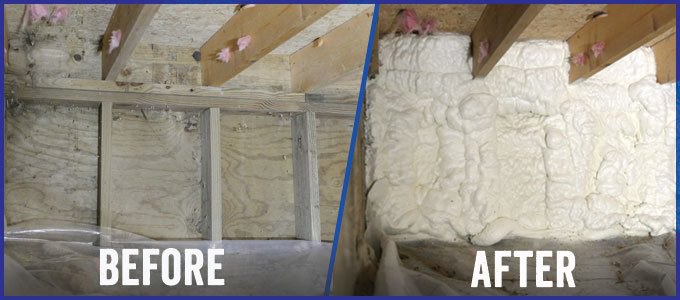What is the Best Crawl Space Insulation? (Spray Foam vs Fiberglass)


You’re tired of dealing with cold floors, so you’re ready to do something about it, but you’re not sure what is the best insulation for crawl spaces.
The two materials considered the best crawl space insulation are fiberglass and spray foam. So of the two, what is the best insulation for the crawl space?
I promise we'll get into all of that, but first let's talk about what is recommended insulation for a crawl space based on what to look out for.
Crawl space walls should be insulated with a non-water sensitive insulation that will work to prevent interior air from making contact with the cold basement surfaces, according to the Building Science Corporation. Allowing that interior air that is normally full of moisture can cause condensation and promote mold and mildew growth.
Many homeowners can reduce energy bills just by adding or updating the insulation in their homes. Many older homes have little to no insulation compared to homes built today, so adding insulation can pay for itself in just a few years, according to the U.S. Department of Energy. This includes the crawl space, which is responsible for cold floors and pesky drafts.
RetroFoam of Michigan has more than 15 years of experience insulating thousands of homes across the lower peninsula. Our experience is installing spray and injection foam insulation, but we also know quite a bit about fiberglass insulation.
As part of our ongoing efforts to educate our customers, we are here to discuss what insulation to use in the crawl space, including the pros and cons that are associated with each one.
Crawl Space Fiberglass Insulation: Pros and Cons
 Fiberglass is one type of insulation for a crawl space.
Fiberglass is one type of insulation for a crawl space.
Fiberglass insulation is a material that is made up of plastic that is reinforced by extremely fine glass fibers. This composition gives the plastic additional strength while improving its insulation capacity.
Fiberglass is a more traditional type of insulation found in walls, attics, and crawl spaces in many older homes. The most commonly used form of fiberglass found in crawl spaces is blankets, which is batts and rolls.
Pros:
- Fiberglass can be a DIY crawl space project for a homeowner with experience and who isn’t afraid of getting dirty.
- Fiberglass insulation is inexpensive for crawl space projects compared to other insulation materials.
- Fiberglass is suited for standard stud and joist spacing for a crawl space.
Cons:
- Fiberglass insulation can trap allergens, dust, and moisture in the crawl space which can promote the growth of mold and mildew.
- When it is disturbed, fiberglass in the crawl space can release particulates into the air which can be inhaled. When inhaled, fiberglass insulation particles can cause coughing, nosebleeds, and other respiratory issues.
- If the fiberglass insulation in the crawl space must be disturbed, the person in the area should wear protective gloves, long-sleeved shirt, pants, and goggles.
- If fiberglass particles comes into contact with the skin, small particles can lodge in pores causing itchiness, rashes, and irritation.
- If the underside of the floor is insulated with fiberglass, gravity will eventually cause the material to droop.
- Fiberglass in the crawl space allows for air flow, which is a major source of cold floors, uncomfortable homes, and high energy bills.
Crawl Space Spray Foam Insulation: Pros and Cons
 Spray foam is the other type of insulation for the crawl space.
Spray foam is the other type of insulation for the crawl space.
Open cell spray foam insulation can expand up to 100 times its original size to fill every nook and cranny creating an air barrier that seals an area stopping air movement.
Spray foam insulation’s main ingredients are water-blown and organic chemical compounds derived from petroleum extracts.
Pros:
- Spray foam is safe for the environment.
- Spray foam is Class One Fire Rated for use in the crawl space, as well as other open cavities in the home.
- The material doesn’t retain water, which means it doesn’t promote mold and mildew growth in the crawl space.
- Spray foam insulates the crawl space by creating an air seal that can help lower monthly energy bills while making the home more comfortable.
- Unlike traditional insulation materials, spray foam isn’t a food source for pests that can get into the crawl space.
Cons:
- Spray foam insulation is often too complex for a DIY project in the crawl space, so it must be installed in the crawl space by an experienced contractor.
- Spray foam is more expensive than other traditional forms of insulation used in the crawl space.
- Some brands of open cell spray foam have a slight odor after it has been applied, so it is important to watch which brand is being installed.
Deciding on the Best Insulation for Your Crawl Space
The Building Science Corporation recommends a foam based insulation as the best insulation for crawl spaces because it creates an air barrier.
This means spray foam is the best floor insulation so you won't need to wear extra pairs of socks.
If you agree that foam insulation is the better option for your crawl space and live in Michigan’s lower peninsula, give us a call at 866-900-3626 for a free estimate, or fill out the form on our website.
Related Articles
Best Way to Insulate Crawl Space with Spray Foam: Walls or Ceiling?
Crawl Space Encapsulation vs Insulation: What's the Difference?
Crawl Space Insulation Problems: Watch Out for These 6 Issues
About Amanda Ringler
Amanda previously has worked as a breaking news and crime reporter, TV news producer, and editor in Flint and Detroit. Throughout her career as a journalist, she has won several awards from The Society of Professional Journalists - Detroit Chapter and the Michigan Press Association. As part of the RetroFoam of Michigan family, Amanda uses her experience as a journalist to write content that will help educate homeowners on the benefits of foam insulation. When Amanda isn’t writing, she’s spending time with her husband and rescued huskies. She also loves knitting, making art, cooking, and hosting dinner and a movie night for friends and family.

.jpg)
